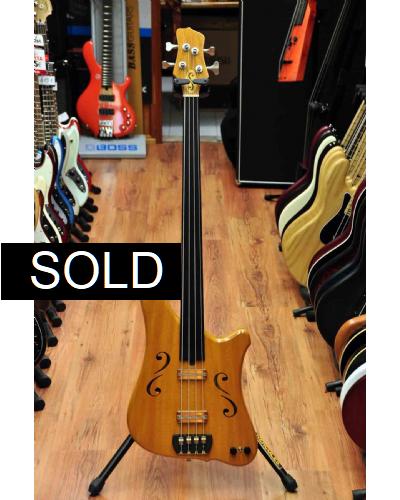From Safran's website:
In 2008 I designed and built my first solid body bass. That followed by several others for another two years. In 2010, my son "Safran" was born. I named my instruments after him, I designed my 'S' logo and it all began. Since the beginning, I focused entirely on passive, hollow body electric basses. In addition to my electric basses, in 2016, I developed an archtop bass which I named "Iris". I am proud to announce the addition of "Iris" to the selection of my musical instruments.
At the age of fourteen, I had my first electric bass. The bass virus got into my blood and I found myself practising all the time. Practising, rehearsing with bands, gigging, quite literally bass guitar became my life.
When I turned nineteen, I decided to take things a step further and went on studying contemporary music in Melbourne, Australia. After completing my first year I wanted to continue my music studies in Europe. I got accepted to the Prins Claus conservatorium in Groningen, The Netherlands. I had the chance to study with great musicians, trying to understand the role of a bass player as a musician.
Pursuing a career as a musician requires absolute love and dedication to the craft and I realised that I had that love and dedication to the instrument itself, ELECTRIC BASS.
I found a school in Belgium where I could learn this 'mysterious' craft called lutherie. That's where I learnt the basics of lutherie and the importance of using traditional hand tools. Blending traditional methods with modern techniques and my approach to lutherie, I have been trying to bring out the full potential of Safran Basses as musical instruments.
One could build a good bass guitar choosing the right species of wood and using quality pickups, electronics and hardware. However, to build a musical instrument, I personally select only the best of the right species of wood, wind my pickups, build my bridges, carve the ‘S’afran sound hole and french polish it by hand. My musical instruments, Safran basses, truly handmade!
Over the years I have selected certain species of wood for my instruments. The selection was purely based on the tone, stability and aesthetical values of the timber, and I try to source responsibly harvested wood as much as I can. I do not believe in adding more options just for the sake of it or for commercial purposes. Also, I do not believe tone-charts and similar marketing gimmicks to predict the tone of a finished instrument.
The tone of timber is best understood through personal experience and knowledge of one's own stock of wood. Of course, the tone of your unamplified electric instrument is only a part of your actual sound. The pickups and amplification are equally important. That is the reason why I make my own pickups in order alter the tone to one's liking before amplification.
Body options: Alder,Ash and Spanish cedar are the main options for bodies with Mahogany, Cherry and Walnut centres. Please enquire for other options.
Neck options: Maple is the main options with Purpleheart or Wenge centres. Ash and Padouk available on request.
Top wood options: There are many options available for top wood. Figured Bubinga, Satinwood, Indian rosewood, Lacewood and more. Please contact to discuss your personal preferences.
Fingerboard options: I use ebony, bloodwood, wenge and various other species.
Safran basses are passive. I stay clear from onboard preamps, electronics etc in order to give you the purest connection between you and your instrument. So you can have the best tone, your hands!
HAND SELECTED TONEWOOD
Perhaps the most challenging aspect of instrument building is, building up the knowledge and the experience of selecting the right wood for your instruments. I take great joy making trips to wood suppliers, going trough a mountain of wood and selecting a handful. From their very beginning as select wood to their completion as a musical instrument, I have a personal connection with every bass that I build. It is my passion!
HOLLOW BODY
Safran basses feature hollow body construction for several good reasons:
- Including another element “air” into the construction of the instrument enhances the overall output, harmonics and the dynamic range. It truly adds another dimension to the natural tone of the instrument.
- To create a lightweight instrument. Weighing under 3,5 kilos (4 string) it’s perfectly balanced and very light weight. Those long gigs are no longer a painful experience.
- To give Safran bass guitars the character of a musical instrument.
EXQUISITE WOODEN BRIDGE
In order to achieve the most organic tone, I build my bridges using wood, brass and bone. Besides being an exquisite handmade bridge, it has all the necessary features to obtain ideal comfort and intonation.
- The saddles can slide in their slots for correct intonation.
- The height of each saddle can be adjusted for the best possible string action.
Double cutaway:
I settled upon bolt-on neck construction for this design. The main reason is that the neck can be separated from the body and replaced if needed, for example, unrepairable damage on the neck. Also, I can build two necks for the same body allowing you to change the neck to fretted or fretless. In addition to that, the truss rod is adjustable from the body which allows me to build thinner necks if required. Super smooth neck and versatility are the key points of this design.
This is a Double Cutaway Model in 4 string fretless version. It sings beautifully unamplified and you get the same natural organic tone when connecting to an amp. Using just the bridge pickup you'll get what most fretless players seek 90% of the time: beautiful singing voice with a lot of "mwah" factor, very responsive to vibrato and great harmonics. The neck pickup is a completely different beast, yielding an almost upright type of tone. Blend both pickups and you'll get an all round sound that you can use for lots of different styles when you need a deep bass sound (even those tunes where you normally would use a fretted bass).




